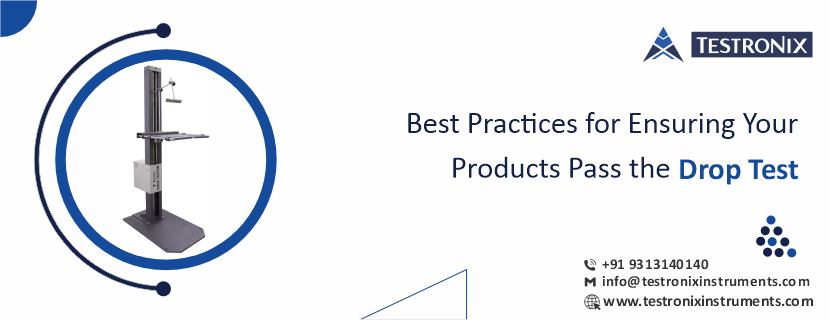Reviewed by Anurag Mishra (Sr. Technical Consultant)

Conducting a drop test of packaging materials is important to assess their ability to protect the product during transit. Packaging plays a critical role in safeguarding products from potential damage caused by drops, impacts, or rough handling. Thus, we at Testronix have designed a high-quality lab testing instrument known as a drop tester that is used to test the resistance of cartons against free falls. This high-quality lab testing equipment provides the provision to uplift the test platform by a guide mechanism.
It comes with an adjustable drop height that will be used to conduct straight and angular drop tests on a single instrument. It comes with a strong base plate with a durable structure that makes this machine last long. This quality drop tester machine helps to identify any weaknesses or vulnerabilities in the packaging design, allowing for improvements to be made to ensure that products reach their destination in pristine condition. In this blog, we will discuss brief information about Testronix drop testing equipment and how you can utilize its power to test the dropping ability of cartons. So, let us get started!
Drop testing is a crucial part of the product development process. It helps you determine whether your product can withstand the impact of being dropped, which is a common occurrence during shipping and handling. A product that fails the drop test can lead to costly returns, warranty claims, and damage to your brand's reputation.
Thus, testing the packaging materials like cartons, against drop tests will help the manufacturers in ensuring the quality of materials delivered to the customers.
Testronix offers high-quality paper & package testing instruments and one of the widely used lab testing equipment is the drop tester manual model that tests the package when dropped from a certain height. It comes with a strong base plate with a durable structure to ensure that quality materials will be delivered to the customers.
This quality testing equipment has been customized as per ISTA standards 1A and 3A on request. You can read more on understanding the mechanism of precise impact testing of drop tester.
Now, let us discuss a brief about Testronix manual drop tester.
The Testronix manual drop tester is a versatile carton drop testing instrument that offers several key features. It is equipped with a provision to lift up the test platform through a guide mechanism, allowing for easy positioning of the test sample.
The drop height is adjustable, enabling precise testing according to specific requirements. The instrument is designed to perform both straight and angular drop tests, providing flexibility in evaluating product resilience. Its strong base plate ensures stability and durability during testing.
This manual lead screw model of the Presto drop tester allows you to accurate load extension capacity measurement. It operates quietly, ensuring noise-free operation, and requires minimal maintenance. The instrument offers customizable flaps and platform sizes, accommodating various product dimensions. It also facilitates edge drop and corner drop tests, simulating real-life scenarios effectively. You can easily use a drop tester for package drop tests.
You can also read about the role of drop tester in the packaging industry.
While drop testing is crucial, many businesses make common mistakes during the testing process that can lead to inaccurate results. Here are some of the most common mistakes to avoid:
1. Inconsistent Testing Conditions
One of the most significant mistakes businesses make during drop testing is inconsistent testing conditions. For example, dropping the product from different heights, angles, or surfaces can lead to inconsistent results, making it difficult to determine whether the product truly meets safety standards.
To avoid this mistake, it's essential to establish clear and consistent testing conditions. This includes specifying the height, angle, and surface type for each drop test. By doing so, you can ensure that each test is conducted under the same conditions, making it easier to compare and evaluate the results.
2. Poorly Designed Test Protocols
Another common mistake is poorly designed test protocols. This includes not specifying the number of drops, the sequence of drops, or the orientation of the product during testing. Without a clear and well-defined test protocol, it's difficult to ensure that each test is conducted consistently and accurately.
To avoid this mistake, it's essential to develop a clear and well-defined test protocol before conducting any drop tests. This includes specifying the number of drops, the sequence of drops, and the orientation of the product during testing. By doing so, you can ensure that each test is conducted in the same way, making it easier to compare and evaluate the results.
3. Using Inaccurate Testing Equipment
Using inaccurate testing equipment is another common mistake made during drop testing. For example, using a drop tester that doesn't accurately simulate real-world conditions can lead to inaccurate results, making it difficult to determine whether the product truly meets safety standards.
To avoid this mistake, it's essential to choose the right equipment for your drop testing needs. This includes selecting a drop tester that accurately simulates real-world conditions and meets the testing standards established by ISTA.
We at Testronix Instruments build drop tester with accuracy and sturdiness that makes it easy for paper & packaging manufacturers to overcome these challenges. You can easily consult us by giving us a call at +91 9313 140 140 or emailing us at info@testronixinstruments.com. Our team of technical experts will consult you regarding all your needs and queries.